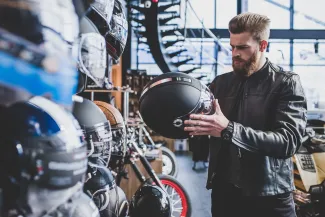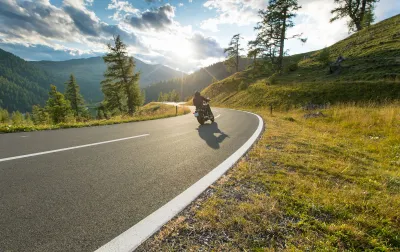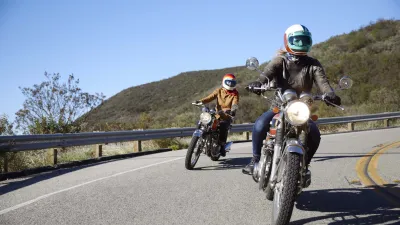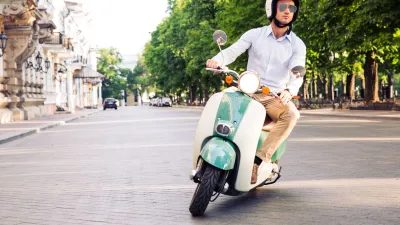Creation date : 15/04/2022
What motorbike equipment is compulsory in Luxembourg?

When it comes to motorbike safety equipment, the law differs greatly from one country to another. In Luxembourg, according to the highway code, only a helmet is compulsory. It must meet the ECE 22.05 standard which controls shock absorption, helmet deformation and other criteria.
What equipment is essential to keep you safe on a motorbike?
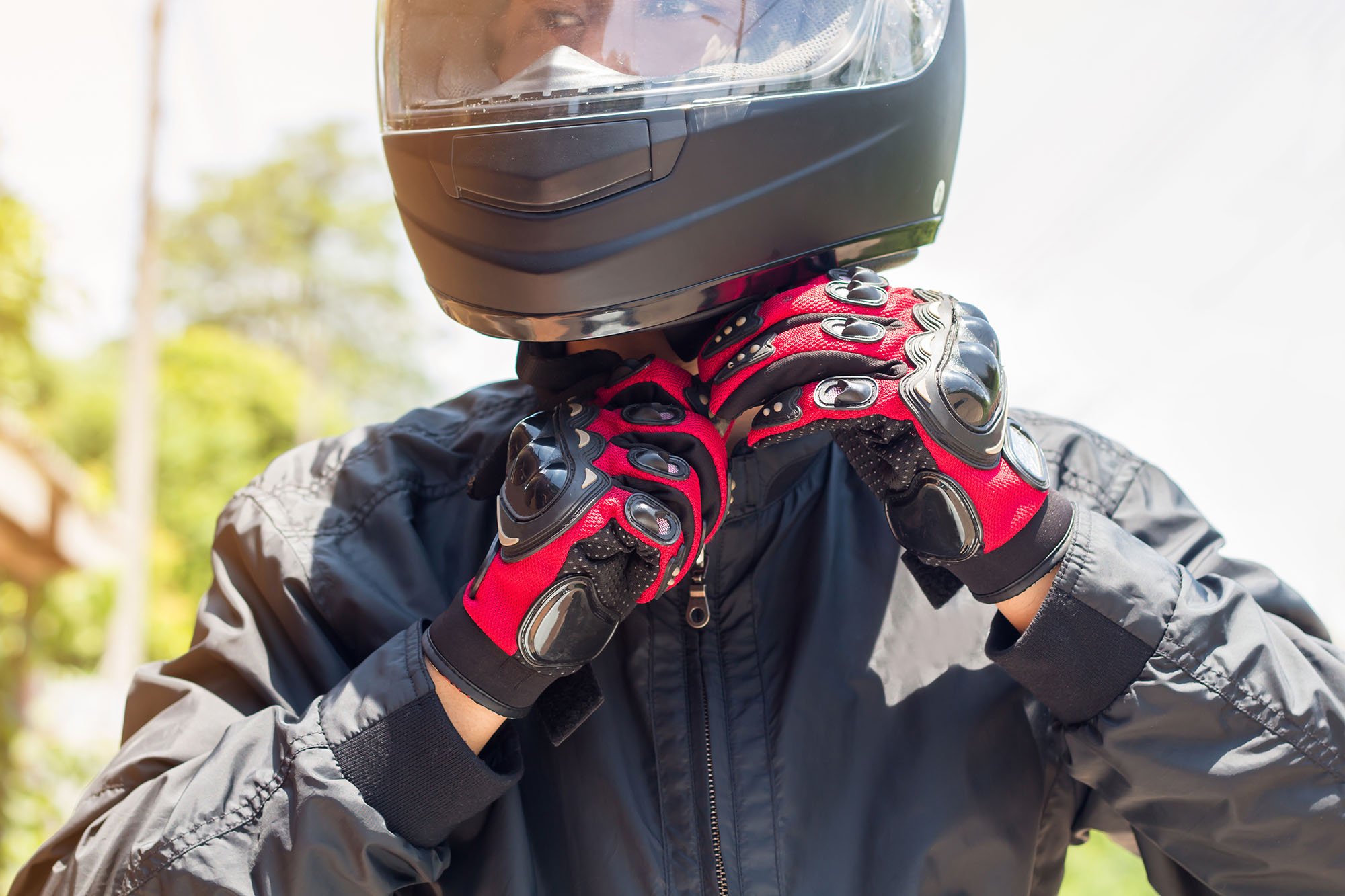
Other equipment is of course essential for your safety: trousers, boots, jacket, gloves, etc. But they are not a legal obligation.
“Riding a motorbike is a bit like skiing. You have to dress from top to bottom and be well equipped. You can ski in jeans, but you run much more risks,” explains Nico, an AXA agent in Bascharage who likes nothing more than heading off on motorbike trips in Luxembourg with friends.
Because beyond comfort, the role of good motorbike equipment is to prevent serious injuries. It protects many parts of the body: shoulder, elbow, wrist, knee, back...
For William, safety has always been a priority. When he passed his motorbike licence 4 years ago, he bought the complete set of equipment (trousers, jacket, back protector, gloves, boots) as soon as he started riding.
Sébastien, a sales advisor with Dainese in Windhof (one of the leading brands in motorbike protective equipment) agrees:
“A complete set of safety equipment is as essential as the bodywork of a car, it’s a no-brainer”, is how he puts it.
Moreover, motorbike schools do an excellent job of raising awareness, so much so that today, most aspiring motorbike licence holders are properly equipped. However, many young bikers still choose to buy cheap motorbike clothing for the licence before re-equipping later. However, investing in the right equipment straight away is the best way to ensure you have the best possible protection without waiting, and thus avoid double-buying.
How much will good quality motorbike equipment put you back?
A complete set of motorbike gear of good quality represents a minimum budget of about €1,000. You can expect to pay 50% more if you go for the big brands.
New motorbike owners often don't factor in these costs.
“Sometimes customers have invested everything in the bike and ask us for a €50 helmet,” explains Sébastien. However, when it comes to motorbike equipment, price is very much linked to the quality of the protection. “This isn’t where you should be cutting corners,” he says.
For example, there is a real difference between a plastic helmet (which is less expensive) and a fibre helmet, which incorporates deformation zones in the event of an impact. Investing in the right safety gear makes all the difference in the event of an accident.
How to choose the right motorbike equipment?

There are 4 main questions to ask yourself when choosing the right motorbike protection:
1. In what conditions will you be riding?
While keeping in mind the absolute necessity of being correctly equipped to ensure your protection, your riding conditions may lead you to choose one material rather than another to take into account the temperature or the bad weather.
- You are a "sunshine biker" who likes to swap your car for your motorbike in summer for short trips, or
- You ride all year round and in all weather to get to work while avoiding traffic jams, or
- You take advantage of the summer to tour Europe on a motorbike
So, if you want to go for a drink on a terrace in summer, you can opt for trousers made of synthetic material, which is more flexible and less hot than leather, and with which you’ll be more comfortable but which is still designed to resist abrasion in the event of a fall.
If you ride at night or in all weather, opt for reflective gear to increase your visibility.
Finally, for long rides and the motorway, opt for leather, which offers the longest resistance to abrasion.
Today's equipment is well designed to let the air through and keep the rider cool, while offering good protection and reinforcements and CE approval.
2. More of a leather or synthetic person?
This choice is not just a matter of personal preference. Each option has advantages and disadvantages, which are summarised below.
Leather:
Advantages:
- It’s the most resistant material to abrasion or tearing. So if you fall, your skin is protected for longer,
- It is also the “coolest” option.
Disadvantages:
- It's a bit cold in winter and bit hot in summer,
- It is a fairly heavy material and not particularly waterproof,
- It requires regular maintenance to nourish the leather.
💡 Pro tip: If you ride every day: opt for a synthetic and waterproof material (leather can stay wet for several days after a heavy rainfall).
Synthetic:
Advantages:
- These are better ventilated materials that "breathe" better,
- It is waterproof,
- It is light.
Disadvantage:
- Less abrasion resistant than leather.
💡 Pro tip: If you ride in all seasons, you will need at least two sets of equipment: one for summer and one for winter to adapt to the temperature outside.
3. Which standard and certification should I choose?
Firstly, check that the equipment you are interested in has European approval, i.e. that the label shows a logo of a motorcyclist.

Then, for each type of equipment, there are two levels of protection:
- Level 1 standard: the lowest, corresponding more to leisure equipment,
- Level 2 standard: which offers greater absorption in the event of an impact and better resistance to abrasion.
4. Size matters
Protection that is a few centimetres off can lead to a broken limb. That's why choosing the right size helmet, jacket or trousers is crucial to ensure good protection. So, even though internet offers are often attractive, remember that there is no substitute for a fitting and advice from a professional to ensure that the equipment fits you properly.
“Every day, I explain to my customers why they should not go up a size to be more comfortable," confirms Sébastien.
Indeed, today's outfits are increasingly fitted so that the protections remain in place in case of a fall. This is why it is recommended to try different suit options, in order to find the right balance between comfort and protection
Democratisation of the motorbike airbag
65% of motorbike accidents in Luxembourg involve a third party*. The danger is constant. Especially since the development of road traffic also plays a major role in the increase in the number of accidents. In recent years, however, a new piece of equipment has triggered a small revolution in motorbike safety: the airbag vest. Its price has dropped considerably, making it more affordable. That being said, it will still set you back a few hundred euros, depending on the technology used.
What is a motorbike airbag? An airbag is a protective device that protects the spine, thorax and abdomen in the event of a fall and/or sudden impact. However, the same name can refer to quite different technologies:
- The wired airbag, the most economical version: The wired airbag is a protective garment connected to the motorbike by a cable. In the event of a fall or impact, the tension on the cable triggers the inflation of the system. This is the first generation of motorbike airbags.
- The radio-controlled airbag: Inspired by the airbag system in cars, some vests incorporate radio-controlled technology via sensors installed on the motorbike. When the system identifies a danger, a Bluetooth wave causes the airbag to inflate. The main advantage over the wired system is the speed with which the airbag is triggered.
- The intelligent airbag with on-board sensors: This is the most technologically advanced option, with sensors directly integrated into the garment. The system is triggered according to the calculation of the trajectory. It even works when the vehicle is stationary. This is the benchmark for competitions, which has now become more widespread. It has the fastest triggering time.
Remember that no equipment protects you 100%, not even the airbag vest. Remember that the right motorbike equipment often means you have to dig deep into your pocket to offer the best level of safety.
At AXA, the "Material damage" guarantee of the OptiDrive motorbike insurance policy covers equipment (helmet, boots, suit, jacket, airbag, gloves) up to €1,500 in case of destruction.
You should also ask our agents to protect you as a driver in the event of an accident (bodily injury, disability or death), because even with the best equipment, prudence remains the best ally for your safety.
* Source Statec: https://www.securite-routiere.lu/wp-content/uploads/2020/04/PDF-10-2019.pdf
An advisor is available in every region of the Grand Duchy to offer you his services and his well-informed advice about insurance solutions : Do you need advice ?
